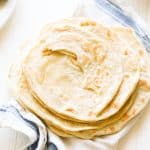
Chapati Recipe
Flaky, layered, and super satisfying flatbread with only five simple ingredients tastes way better than store-bought. The mild, nutty flavor is ideal for beef stew and other meat or veggie dishes. And what better way to relieve stress than kneading bread?
Servings 6
Calories 296kcal
Ingredients
- 3 cups all-purpose flour
- 1 teaspoon sugar
- 1½ teaspoons salt
- 3 tablespoons ghee (clarified butter or oil)
- 1¼ cup warm water
Instructions
- In a large bowl, add flour and make a well, then add sugar and salt, followed by water and ghee or oil.
- Knead to form a soft and sticky dough.
- Place dough on a heavily floured board and knead for 8-14 minutes. Continue to flour dough as needed to facilitate kneading. Be careful not to overdo it. The dough should be soft, elastic, and smooth.
- Divide dough into 6 or 8 pieces according to preference and let it rest. Resting helps to relax the gluten and makes it not only easier to work with but also produces tender chapati.
- Using a rolling pin, roll out the dough balls into a circle. They don't have to be perfect.
- At this stage, you may cook them. However, if you want chapatis with layers, follow the next steps.
- Lightly oil chapati dough with ghee. Be gentle.
- Then place the dough on a heavily floured plate, and press the dough down.
- Turn it over and press down again – lightly shake off excess flour.
- Shape dough like you would shape a paper fan - starting at one end and folding all the way to the opposite end.
- Then coil it up - like in the picture.
- When all the dough circles have been coiled, cover them with a damp cloth and let them rest for 20 minutes.
- Gently flatten each coiled ball and roll it out. Begin rolling from the center, working outwards.
- Rotate the dough out each time you roll it. That helps to make a perfect circle. Make sure they are not rolled out too thin. Chapatis are not meant to be thin - a ¼-inch thickness is good.
- Oil the pan. Then place the chapati on it. I used a crepe pan, but a skillet works just as well.
- Heavily oil the other side of the dough, making sure you oil the edges too.
- Cook for 2-3 minutes, rotating as needed until golden brown.
- Serve warm.
Notes
- The right amount of kneading is crucial. Gluten won't develop well without it, changing the texture. Also, oil makes the chapati soft and prevents it from drying out.
- Lukewarm water creates a smoother, more supple dough, but remember to add it gradually so the dough doesn't get too wet.
- Resting time is also essential since it makes the dough easier to roll without breaking apart.
- Be careful not to overcook it. A non-stick pan helps prevent the bread from sticking and burning.
- Please remember that the nutritional information is a rough estimate and can vary significantly based on the products used in the recipe.
Nutrition
Serving: 1chapati | Calories: 296kcal | Carbohydrates: 48g | Protein: 6g | Fat: 8g | Saturated Fat: 5g | Polyunsaturated Fat: 1g | Monounsaturated Fat: 2g | Cholesterol: 19mg | Sodium: 585mg | Potassium: 67mg | Fiber: 2g | Sugar: 1g | Calcium: 11mg | Iron: 3mg